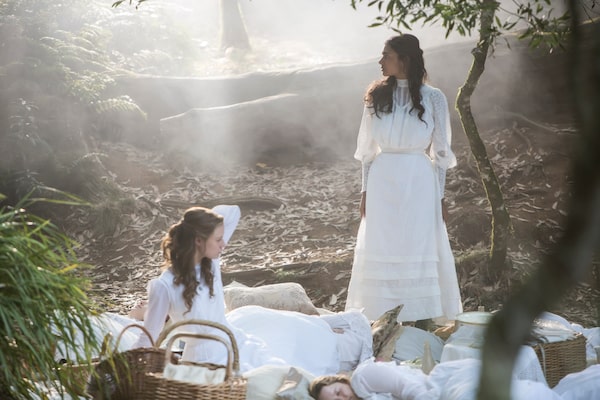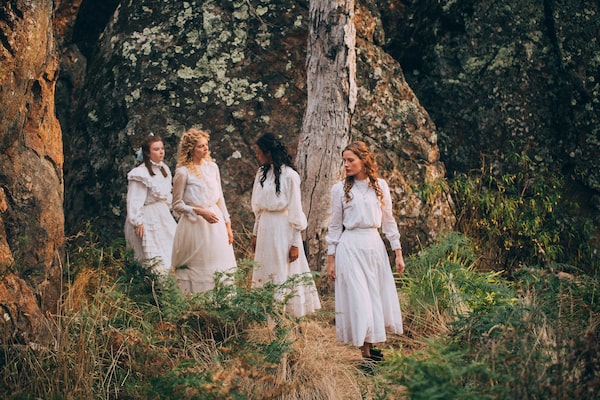At the beginning of the three-month shoot for her new miniseries Picnic at Hanging Rock, in the environs of Melbourne and the wilds of Victoria, Australia, the Canadian director Larysa Kondracki thought to herself, “Okay, we’re a group of people locked up on the other end of the world, talking about teenage hysteria. This could go one way or the other.”

Larysa KondrackiMatt Doyle
Kondracki, who in a phone interview speaks in a dry, wry tone that conveys brains and drollery, had put in her time on a lot of sets. Her 2011 film The Whistleblower, starring Rachel Weisz, had been nominated for six Genie Awards, and she’d directed episodes of (among others) The Americans, Better Call Saul, Legion, and The Walking Dead. She had learned which way she wanted things to go.
On most series, writers stay put, while directors drop in, do an episode or two, and leave. To be any good, a director has to quickly suss out which way the wind blows. “You see which shows work, and how to run a good show,” Kondracki says. “Vince Gilligan on Better Call Saul, and Noah Hawley on Legion, run happy, respectful places. They’re entirely aware of their story and what their show is, but they’re so open to collaboration and ideas.”
Picnic at Hanging Rock, which arrives June 17 on Bravo, was Kondracki’s first outing as showrunner, so she took everything she had learned and added two innovations of her own: A strict no-jerks policy, and wine bribes (the craziest ideas that make it on screen earn bottles of wine).
It worked. “The cast and crew – 70 per cent of whom were women – got really into it,” Kondracki says. “We rehearsed at night, on weekends. Production there is tough – it’s hot, the weather is unpredictable. We had Game of Thrones level ambition, with a fraction of the budget. Everyone was running, everyone pitched in.”
Picnic at Hanging Rock is an emotional thriller set in 1900. Students and teachers from a strict but out-of-the-way girls’ finishing school, run by the mysterious Hester Appleyard (Natalie Dormer), go on an outing to the famous rock. A teacher and three students -- Miranda (Lily Sullivan), a willful free spirit; Irma (Samara Weaving), a beautiful heiress; and Marion (Madeleine Madden), who is bright and mixed-race – set out for a walk and vanish without a trace. Eventually, one turns up, but can remember nothing.
Kondracki was initially leery about taking it on. She’d analyzed Peter Weir’s 1975 movie in her graduate film program at Columbia University. She also knew that Australians are “cuckoo bananas” about the 1967 source novel by Joan Lindsay: “It’s like The Great Gatsby and Shakespeare and the Bible rolled into one,” she says. “They study it in school; it’s part of their folklore. It begins with Lindsay saying to the reader, ‘It’s up to you whether you think this is a true story.’ There’s a choose-your-own-adventure aspect to it. In the 1970s, for example, everyone was like, ‘A spaceship took them.’”

Miranda (Lily Sullivan) and Marion (Madeleine Madden) in a scene from Picnic at Hanging Rock.amazon
After reading the miniseries’ scripts, by Beatrix Christian, Kondracki was hooked. “Bea says so much with so little, it’s almost poetic,” she says. “As with the book, she’s emotionally specific, but it’s really open to interpretation. It’s about the disappearance, but it’s more a chance to talk about who these girls were, and give them agency. It asks the questions, ‘What is it like to be a girl?’ and ‘What kind of girl do you want to be?’ Which also apply to contemporary, adult, professional women. It’s about control versus rebellion.”
Kondracki’s ideas for it encompassed everything from John Wayne in the doorway at the end of The Searchers (“frames within frames”) to The Breakfast Club (“You’ve got the jock and the beauty and the brain, and there’s this hope that maybe one person can be all those things”). She wanted to use the kind of “big, muscular lenses” that directors like Michael Mann use for closeups on Robert DeNiro and Al Pacino, to make it “Stanley Kubrick meets Heathers.”
The wine bribes resulted in some haunting images – girls hanging from clotheslines by their hair; sheets of rushing water; shots of the ground shaking and the world spinning –“these in-camera tricks that give it a crunchy, retro, low-fi vibe that separates it from the heavy visual-effects stuff that’s happening everywhere now,” Kondracki says. She also mixes in modern sounds – typewriters, computer pings and race car engines, “a Jetsons spaceship under water with a cat moaning” – to throw the viewer out of time.
As well, she wanted to bring the story to an emotional conclusion without turning it into a whodunit. “It’s about who the girls were and why they wanted to run away,” she says. “I have a theory -- and people should argue about this – that the whole story happens in Hester’s head. These are all the types of girls she could have been.”
Characters get their periods, bathe each other, curl up together in bed, but Kondracki moves the mood away from psycho-sexual hysteria, toward exploration and acceptance of the self. “So rather than sexuality, it becomes about confidence and ownership,” she says, “about finding your inner beauty, strengthening that, and figuring out how to manifest it on the outside.” She also had a blanket rule: no female frontal nudity, only male.

The students set out to explore Hanging Rock.
Her casting process was “taxing and lengthy,” Kondracki says. “Miranda is an iconic character. It’s like casting Jesus.” But she felt she’d found the perfect actresses – until she saw them in full hair and makeup. “I had a freakout,” she admits. “As a female filmmaker, I was thinking, ‘These girls are way too beautiful, everyone who sees this is going to feel awful about themselves.’” Her department heads had to talk her down. She realized if she made the world around them as beautiful, it would ground them.
“I ended up thinking differently of myself as a woman,” Kondracki says, chuckling. “I bought a lot more clothes and makeup.” As a woman in a mostly male profession, “You think you have to be a certain way, but then you think, ‘Well, why can’t I?’ Yeah, it adds more time to your day, but you do walk around with just a little more confidence and optimism. It taught me a lot.”
She plans to continue producing and showrunning; her next project is a six-part series based on Anne-Marie MacDonald’s 2003 novel The Way the Crow Flies. “We’re in the middle of setting it up. I’m meant to direct all six,” Kondracki says. “The story is so powerful, and the adaptation is glorious. It becomes this Terrence Malik-type thriller, but underneath it’s a meditation on life. It has elements of Big Little Lies and The Night Of , but also Stand by Me . I want to make Canadiana special, in an art/poetic way.”
Kondracki’s takeaway from Picnic at Hanging Rock is simple, but that doesn’t mean it’s easy: “I’ve learned that you have to be your happiest self,” she says. “With experience comes confidence. Directors tend to think they need to know 100 per cent what’s happening, and you have to have a strong kernel of that. But if you’re inclusive, you generally get a better result. Otherwise, you’re just announcing what’s in your head, and you rob yourself of what others can bring.” Call that a female sensibility if you will. I call it the right way to go.
 Johanna Schneller
Johanna Schneller